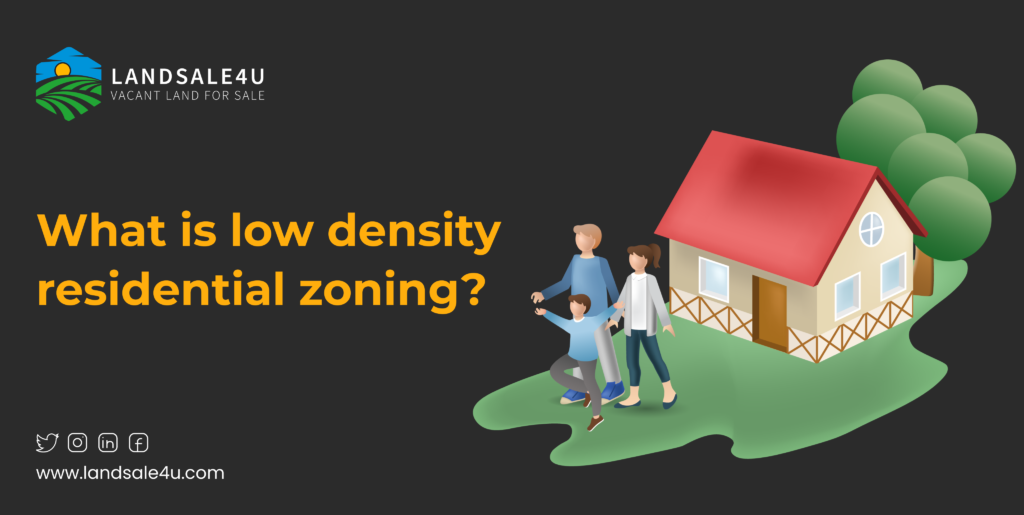Low Density Residential Zoning- Residential zoning areas are becoming more noticeable as the population continues to swell up in the 21st century.
It has compelled the governments of various nations to put up specific ordinances and laws for residential zones to ensure we do not cause any harmful threat to the flora and fauna on the planet Earth.
Furthermore, zoning assists in city planning and can be considered to be an essential component that aids in maintaining the overall equilibrium of the place.
Whether you are planning to shift your base to the United States of America or any other nation for better job and life opportunities or thinking of relocating to a different state in the nation, it is vital to understand what the term low-density residential zoning means before zeroing out the accommodation spaces.
Read out this blog to understand what this term specifically means!
Table of Contents
Low Density Residential
The low-density residential ordinance is implemented to put a limit on the density of dwellings per acre of a property.
Each municipality in America usually enacts its own ordinance rules based on its needs and preferences.
For instance, according to available data, Crystal City, Minnesota allows less than five dwellings in low-density residential zones whereas in Virginia, Jefferson City County the permission is only for a single dwelling per acre.
What is Low Density Residential Zoning?
The Low-Density Residential Zone applies to the small unserviced residential settlements and even existing low-density residential areas as well as those plots which cannot be expanded further to higher residential densities due to multiple constraints such as environmental, landscape, existing character and infrastructure limits.
This type of zoning is usually applied to residential lands that are located in the vicinity of larger urban settlements. Apart from the limits on the number of accommodation places, these zones also include home businesses, parks and other refreshing amenities provided that their use is compatible with the rules meant for low-density residential amenities.
The main purpose of this type of zone is –
- To provide land for residential purposes
- Ensure overall development of larger residential plots in zones with limited infrastructure and environmental constraint
- To avoid conflict with adjacent Rural Resources or Significant Agricultural zones by providing adequate buffer areas
- To offer existing low-density residential zones with optimum reticulated services by meticulously limiting the subdivision potential
Low-Density Residential Zone
As per the available information, the low-density residential zones have many more restrictions apart from the density limits of property in an area.
These include the following rules –
- A single family can feel detached from the community and the outside world due to less accessibility to the community, recreational activities or socialization
- Detached housing leading to large setbacks from streets, local market or between two neighbors
- Denial of permission to run any kind of home daycare business or provide business services
- A cap on the number of children or office workers within the premises if permission is attained
- A standard restriction on the garage, sheds, swimming pools or other structures according to rules laid by the municipality
Every zone comes with its own set of pros and cons. Low-density residential zone also has their positives and negatives which are discussed below –
Advantages
- Less congestion
- Light neighborhood traffic
- Low noise
- A higher degree of privacy
- Shuns unnecessary nonsense for a peaceful life
- Immense self-realization
Disadvantages
- Less efficient use of land
- Long commute and travel times to urban sprawl
- Not cost-efficient for all
- Less diverse communities
- Impact on social life
- Can impact overall health and mentality
- Emergency cases can become complicated with limited resources
- Affects the overall development and potential of an individual
- Behavioral changes possible
Low-Density Residential Land Use
According to the General Plan of the American government, the Low-Density Residential (LDR) Zone is intended to be utilized in accommodation areas that are designated to have a density range of two and no/tenths (2.0) to five and eight-tenths (5.8) dwelling units.
In addition to the rules of the District, low-density residential land use specifies, for permit section S8 Monitoring and Assessment, one dwelling unit allowed per 1 to 5 acres on a piece of land.
If you are scanning a residential place in Tennessee and want to have comfortable accommodation, have a look at what we offer in Washington County at – https://landsale4u.com/property/land-for-sale-in-coffee-county-tn-rya4dj8/
If you are searching for accommodation in a low residential zone in Franklin County TN, then Landsale4u is the site you need!
Our expertise in assisting you to locate the right residential zone that suits your needs makes us a preferred brand among customers. We abide by the municipality rules and promise to deliver the best to our customers at very budget-friendly rates.
Have a look at www.landsale4u.com and turn your apartment of dreams into a reality!

